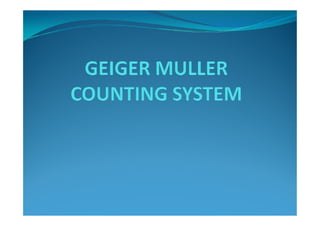
Geiger muller counting system
- 2. Introduction Particle detector measures ionizing radiation Detect emission of nuclear radiation: alpha particles, beta particles or gamma rays Detect radiation produced by ionization produced in a low pressure gas in a geiger muller tube Each particle detected produces a pulse of current Used for measurement in health, physics, industry, geology and other fields
- 3. Setup Geiger-Muller (GM) Counter consists of a GM tube having a thin end window (e.g. made of mica) a high voltage supply for the tube a scaler to record the number of particles detected by the tube and a timer which will stop the action of the scaler at the end of a preset interval any particle capable of ionizing a single atom of the filling gas of the tube will initiate an avalanche of electrons and ions in the tube
- 4. The collection of the charge thus produced results in the formation of a pulse of voltage at the output of the tube The amplitude of this pulse, on the order of a volt or so, is sufficient to operate the scaler circuit with little or no further amplification The pulse amplitude is largely independent of the properties of the particle detected, and gives therefore little information as to the nature of the particle
- 5. Setup
- 7. Different regions of operation
- 8. Fill gases and Quenching Because of the fact that the Geiger counter is based on positive ions that will be formed inside of the tube, gases that form negative ions, such as oxygen, should be avoided at all costs. Usually noble gases are used as the main component in the Geiger counter. There is a mixture of two gases in this chamber, however, to allow for quenching.
- 9. As radiation enters the detector it ionizes the gas inside the chamber. These ions drift away from the anode wire after the termination of a Geiger discharge. When these ions drift out to the cathode wall, they are neutralized by combining with an electron from the cathode surface. In situations where the liberated energy is greater than the cathode work function, it is energetically possible to liberate more than one electron. This is a significant issue that needs to be addressed as the free electron can drift into the anode and trigger another Geiger discharge which would penultimately cause the liberation of more free electrons and ultimately cause the Geiger counter to produce a continuous output of pulses. In order to deal with this, a second gas, known as the quench gas, is added to the Geiger chamber in addition to the main gas having an ionization potential that is lower than and a more complex structure then the main gas.
- 10. Typically, concentrations of 5 – 10% are present inside the counter. The positive ions created from incident radiation are mostly the primary gas in the chamber. As these ions drift to the cathode wall, they interact with the quench gas and will transfer their charge due to the difference in ionization energies. The goal here is to have the quench gas bring the positive charge to the cathode wall. This is desirable because the excess energy will go into the disassociation of the quench gas molecule instead of liberating another electron. Ethyl alcohol and ethyl formate havebeen popular choices for quench gas inside modern Geiger counters.
- 11. Dead time The geiger muller has an unusally large dead time.right after a geiger discharge, the electric field is reduced below the critical level to trigger chain avalanches. This time takes the geiger counter to build the electric field back up to critical levelis known as dead time.
